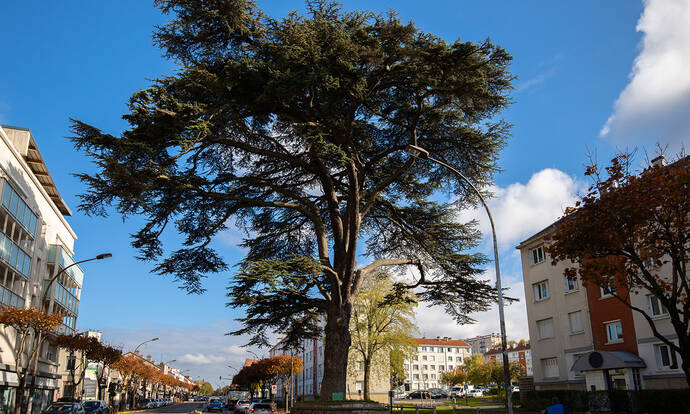The cedar of Lebanon

Proudly adorning the former RN3 for nearly 266 years, the Lebanese cedar is one of the symbols of our commune.
The cedar of Livry-Gargan, unmissable emblem of the City
Large tree, it belongs to the family Pinacea (pine, fir, spruce). Originally from the Middle East, and in particular from Lebanon, where it is sacred (quoted 77 times in the Old Testament). At present, the most important settlements are in Turkey (source : http://edu.mnhn.fr/).
A symbol of fertility and abundance called the “Tree of Power”, cedar is known for the medicinal properties of its young shoots (buds). Moreover, its wood was exploited for the construction of sacred monuments and boats because of its resistance (Example: Salamon temple in Jerusalem).
After the Crusades, several attempts to acclimatize the Lebanese cedar in France took place but were unsuccessful. It was in 1734 that the botanist Bernard de Jussieu brought back two feet of England, a specimen of which is still visible in the Jardin des Plantes in Paris, where he was a curator. Legend has it that during his trip, Bernard de Jussieu broke the pots, so he had to carry them in his hat.
The introduction in France was so popular that many owners of large estates used it as an ornamental tree in their parks.
A Livryen landmark
Around 1750, the Duke of Lorges planted a Lebanese cedar on the edge of his Grand Berceau estate (8.34 ha) in Livry-Gargan.
This estate, which extended from the ex-RN3 to Rue Saint-Claude, was acquired in 1743 by the Duke of Lorges. He did important work there: construction of a chapel and buildings opening onto a rectangular courtyard open to the south-east. The estate passed from hand to hand. The last owner before the Revolution was Madame Marie-Marguerite Magon de la Lande, widow of the colonel of the Rouergue regiment, Jean-Baptiste Hérault de Séchelles, friend of Danton and executed during the Terror. It was sold to the municipality in 1932.
The domain has now disappeared, but the cedar is still present. Bordered by the ex-RN3, the path was diverted in order to preserve the cedar. It is now 28 metres high, with a wingspan of 30 metres and a trunk of 4.55 metres in circumference. Having become a symbol and a landmark for the inhabitants of the city, the current Local Urban Plan (PLU) protects this remarkable tree under the Identified Landscape Elements.


 Mes démarches
Mes démarches